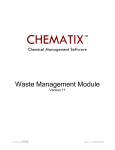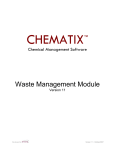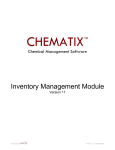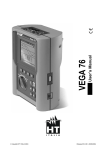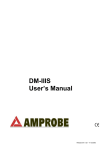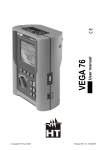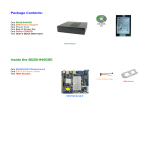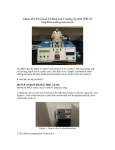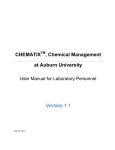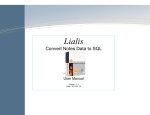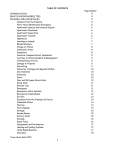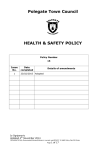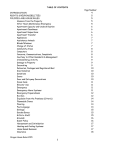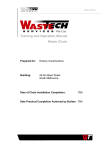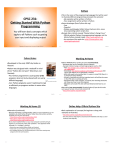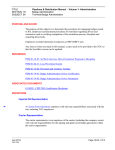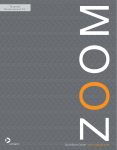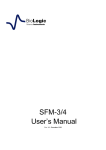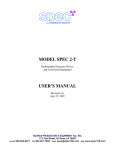Download Hazardous Materials Disposal Handbook – Chemical Waste
Transcript
Hazardous Materials Disposal Handbook – Chemical Waste Created by: Date: Stuart Elle Revised by: September 22, 2009 1. Date: n/a n/a Introduction .......................................................................................................................................... 2 1.1. Purpose ......................................................................................................................................... 2 1.2. The Role of Hazardous Materials Services .................................................................................... 2 1.2.1. Hazardous Materials Services Contact .................................................................................. 2 1.3. The Role of Waste Generators ...................................................................................................... 2 1.4. Clean Glass and Plastic .................................................................................................................. 2 2. Chemical Waste .................................................................................................................................... 2 2.1. Step One: Waste Types and Containers........................................................................................ 2 2.1.1. Chemical Compatibility ......................................................................................................... 2 2.1.2. Container Preparation .......................................................................................................... 3 2.1.3. Liquid Waste.......................................................................................................................... 3 2.1.4. Chemically Contaminated Solid Waste ................................................................................. 5 2.1.5. Ethidium Bromide Waste ...................................................................................................... 6 2.1.6. Compressed Gases ................................................................................................................ 6 2.1.7. Batteries ................................................................................................................................ 6 2.1.8. Unknowns, Forbidden Chemicals, and Potentially Explosive Chemicals .............................. 6 2.2. Step Two: Complete Waste Authorization ................................................................................... 7 2.2.1. Chematix Users ..................................................................................................................... 7 2.2.2. Non-Chematix Users ............................................................................................................. 7 2.2.3. Pure Chemical Waste Form ................................................................................................... 8 2.2.4. Mixed Chemical Waste Form ................................................................................................ 8 2.3. Step Three: Waste Collection........................................................................................................ 9 2.3.1. Chematix Users ..................................................................................................................... 9 2.3.2. Main Campus ........................................................................................................................ 9 2.3.3. South Campus ....................................................................................................................... 9 2.4. Large Quantity Pickups ................................................................................................................. 9 2.5. What Happens to Chemical Waste ............................................................................................. 10 3. Waste Rejection .................................................................................................................................. 10 3.1. Rejection Procedure.................................................................................................................... 10 3.2. Reasons for Rejections ................................................................................................................ 10 3.2.1. Door Locked ........................................................................................................................ 10 3.2.2. Waste Authorization Missing, Incomplete or Improperly Completed ................................ 10 3.2.3. Waste Container Overfilled................................................................................................. 11 3.2.4. Improper Container For This Type of Waste....................................................................... 11 3.2.5. Waste Container Leaking or Improperly Sealed. ................................................................ 11 3.2.6. Exceeds 12L Limit For Similar Waste In Glass Containers ................................................... 11 3.2.7. External Contamination ...................................................................................................... 12 4. Revision History .................................................................................................................................. 12 1 1. Introduction 1.1. Purpose The purpose of this handbook is to provide a concise source of information for most areas of waste disposal and collection as it concerns the activities of Hazardous Materials Services (HMS); however, this manual cannot cover all possible situations. In cases where you cannot find an answer to your waste questions, please contact HMS at the email address in Section 1.2.1. 1.2. The Role of Hazardous Materials Services Hazardous Materials Services (HMS) is responsible for collecting, transporting, shipping, recycling and disposal of chemical, biohazardous and radioactive waste generated by University of Calgary labs and facilities. This is done in accordance with transportation and environmental law and regulations for hazardous materials. 1.2.1. Hazardous Materials Services Contact Email: [email protected] 1.3. The Role of Waste Generators Personnel in labs and other facilities at the University of Calgary that generate chemical waste are considered the Waste Generator for legislative and regulatory purposes. Generators of waste are responsible for, and required to, provide an accurate and detailed record of the waste they are generating and disposing. Waste generators are also responsible for safely collecting, storing and sorting (when required) waste prior to its pickup and transport by HMS for disposal or recycling. 1.4. Clean Glass and Plastic Provision of blue buckets for collection and removal of clean glass and plastic disposal is the responsibility of Caretaking. Please contact them at 403-220-7555 with questions about clean glass and plastic disposal, or visit https://ci.ucalgary.ca/irequest/irequest2.asp?sk=yes for requests. 2. Chemical Waste 2.1. Step One: Waste Types and Containers HMS will only accept mixed waste that is placed in a container compatible with the waste type, or pure chemicals in original or compatible containers. The container must have a secure lid or cap to prevent spills when the container is moved. HMS is not permitted to transport explosive materials, or materials that require an Emergency Response Assistance Plan (ERAP). HMS will not accept Unknown chemicals or Potentially Explosive Chemicals that destabilised. Refer to Section 2.1.7 for more information. 2.1.1.Chemical Compatibility All chemical wastes must be segregated according to chemical compatibilities and/or Transportation of Dangerous Goods regulations. Some of the categories to consider when segregating your waste include: 2 Corrosives – Acid solids and liquids Corrosives – Base solids and liquids Oxidizers and Organic Peroxides – solids and liquids Compressed Gases (non-returnable) Flammable Liquids Flammable Solids Toxic Materials – solids and liquids Environmentally Hazardous Materials – solids and liquids 2.1.1.1. Container Contents HMS would like to emphasize the importance of accurate and continuing accounting of each container’s contents for the safety of everyone involved from generation to disposal. The pictures below (Figure 1 & 2) show what can happen when incompatible chemicals are mixed due to improper reporting. Figure 1 Figure 2 2.1.2.Container Preparation Closely inspect the exterior of any container for contamination and remove any contamination found; if the container has chemical residue, or is excessively dusty, please wipe the container clean. HMS is unable to accept any contaminated or compromised containers for collection. External contamination is anything that is not part of the container except for labels or added markings. 2.1.3.Liquid Waste There are several choices available for storing liquid waste. Liquid waste containers provided by HMS include chemical safety cans (red), and tight head containers (white). Labs may re-use empty glass or plastic bottles of 4L or smaller volumes with compatible contents. HMS will issue containers to labs that produce enough waste to fill a container every one to three weeks. For safety reasons, HMS encourages labs that do not generate this amount of waste to use a smaller container and dispose of it regularly to reduce the potential of 3 adverse chemical reactions taking place and reduce the chances of the materials becoming unknown. If you are producing two or more categories of waste (see 2.2 above), please inform HMS so that HMS can issue your lab the appropriate containers for the volume and type of waste generated. Please contact HMS if you are unsure of what kind of container is compatible with the waste your lab is producing. 2.1.3.1. Filling the Container White tight head containers (Figure 3) come in two sizes (20L and 10L), and allow you to see the level of the contents when filling them. A Maximum Fill line is indicated on the exterior of the container. If the liquid level is exceeded, HMS will not collect the filled container or issue a replacement. The maximum liquid volume for large tight heads is 20 litres. The maximum liquid volume for small tight heads is 10 litres. Figure 3 Red chemical safety cans (Figure 4) are opaque, and there is a metal spark arrestor inside the opening that prevents direct visual inspection of the liquid level. There are, however, several means to safely determine the level of liquid inside the safety can. 1) Keep a log of the chemical volumes added to the safety can. This is the preferred method for safety reasons. The maximum liquid volume for chemical safety cans is 18 litres. 2) If liquid is visible within the spark arrestor, the safety can is overfilled and some of the contents will need to be removed off before HMS will pick up the waste. An accounting of the waste contents removed to a new container must be made. 4 Figure 5 Figure 4 All other containers should have at least 10% to 20% empty space to allow for expansion and gasses forming. In 4L glass bottles (Figure 5) the liquid should be no higher than the start of the curve to the neck of the bottle. The maximum liquid volume for 4L glass bottles is 3.5 litres. If you are not using a pre-numbered container supplied by HMS, please mark the container with your building and room number (e.g. PP250). If you have more than one container, please add a dash and an identifying number to the room number (e.g. PP250-1, PP250-2, etc.). A brief description of the container contents (e.g. “Acid Waste”, “Halogenated Solvents”) is also helpful. 2.1.4.Chemically Contaminated Solid Waste Anything that is not a syringe or other sharp, and has come into contact with chemical (such as paper towel, bench coat, weighing boats, gloves, etc.) that cannot be cleaned, is considered contaminated solid chemical waste. Collect chemically compatible wastes in a plastic bag, and place in a fibre board (cardboard) box sealed with tape. Please indicate the presence of any glass (intact or broken) on the Waste Authorization. Mark the box with your building and room number (e.g. BI 250). If you have more than one box, please add a dash and unique identifying number to the room number (e.g. BI250-1, BI250-2, etc.). 2.1.4.1.1. Syringes and Sharps Syringes and other sharps (e.g. blades) are disposed of in yellow biohazard buckets if they are used in quantity. See the Biological Disposal Handbook for information on disposing of biohazard buckets. For small quantities of sharps, please purchase an approved sharps container of the appropriate size. Sharps containers should include the words “SHARPS” in uppercase on the Waste Authorization form. 5 2.1.4.1.2. Silica Waste Contaminated silica waste should be collected separately from other debris. 2.1.5.Ethidium Bromide Waste Ethidium bromide waste is handled separately from other chemical waste. Small volumes (less than 1L) of liquid ethidium bromide waste can be disposed with other toxic liquid waste. Larger quantities must be disposed of in a separate container. Like any other hazardous material, ethidium bromide in any concentration, or from any source, must never be flushed down a sink. Any solid waste (not including gels) contaminated with ethidium bromide must be segregated and prepared as chemically contaminated solid waste (see Section 2.2.3). Gels contaminated with ethidium bromide are disposed of in white buckets (right) supplied by HMS. These are lined with a clear plastic bag, and come with a cable tie. Please drain excess liquid from the gels prior to disposal in gel bucket (and dispose of the liquid as above). When you are ready to contact HMS for pickup, seal the bag with the cable tie and close the lid. If there is any solid waste other than gels in the bucket, it will be rejected. Figure 6 2.1.6.Compressed Gases HMS collects small compressed gas cylinders (e.g. lecture bottles, propane) and aerosol cans for disposal. For compressed gas cylinders, please check with the original vendor if they have a cylinder re-use or recycling policy that would return the cylinder to the vendor. 2.1.7.Batteries HMS collects all types of batteries (lead-acid, alkaline, lithium, nickel-metal hydride, etc.) for recycling or disposal. 2.1.8.Unknowns, Forbidden Chemicals, and Potentially Explosive Chemicals At this time, HMS cannot accept unknown chemicals of any kind as the current disposal policy is under review. Please store unknown chemicals in a safe manner until such time as HMS and the University are able to properly dispose of these chemicals in a safe manner. Some chemicals are Forbidden for transport under the Transportation of Dangerous Goods regulations. HMS cannot accept these chemicals since HMS does not have permission to act as a carrier for these chemicals (e.g. 2,4-dinitrophenyl hydrazine). Please store Forbidden chemicals in a safe manner until such time as HMS and the University are able to properly dispose of these chemicals in a safe manner. 6 Some chemicals can deteriorate over time to form Potentially Explosive Chemicals (PECs). HMS cannot accept PECs believed to have deteriorated into an unstable state (e.g. dry picric acid). Please refer to the chemical MSDS for information about PEC hazards. Please store PECs in a safe manner until such time as HMS and the University are able to properly dispose of these chemicals in a safe manner. 2.2. Step Two: Complete Waste Authorization 2.2.1.Chematix Users Chematix users should submit their waste pickup requests through a Chematix Waste Pickup Worksheet. Refer to the Chematix User Manual for this process. 2.2.2.Non-Chematix Users There are two types of Waste Authorization Forms: one for Pure Chemical, and one for Mixed Chemical. A Pure chemical is defined as partially used or unused, or aqueous, chemicals in original or replacement containers with a single chemical constituent. (e.g. solid sodium hydroxide or hydroxide solution) Each Waste Authorization Form requires the following information in the top section be completed prior to pickup for disposal: Supervisor’s Name: Principal Investigator’s name. Applicant Name: Name of Person who prepared the waste. Any questions or concerns regarding the waste by HMS will be directed to this person. Work Phone: Phone number the person who prepared the waste can be reached during regular working hours. Date: Offered for pickup Building: Building the lab or room is located in. Room/Lab: Lab or room number where the waste is located. Department: Which department is responsible for the room or lab. Container No.: The number of the container that corresponds to the waste detailed on the form. For reusable containers supplied by HMS, this is the tracking number on the container. For all other containers, this is the building and room number as indicated in Section 2.2.1.2 and Section 2.2.2. Each Waste Authorization Form requires the following information in the bottom section be completed prior to pickup for disposal: Signature of the person who prepared the waste Date of signature 7 The middle section is where you list the chemicals and quantities for disposal. The full chemical name in clear English is required for emergency responders. Chemical formula or structures are not acceptable due to regulations and will result in rejection or delay in pick-up. Quantity, and concentration if applicable, of each chemical. Percentage of the total volume or weight of the chemical in the container is acceptable. The state (solid, liquid or gas) for any pure chemicals. Total volume and/or mass of the waste in the container 2.2.3.Pure Chemical Waste Form Either Section A or Section B (in the middle part of the form) must be completed. Section A is used for pre-classified lists of pure chemicals. Please refer to Section 2.4 Large Quantity Pickups for more information. Section B is used to list limited quantities of pure chemicals. The chemicals listed must conform to a single Primary Class according to TDG regulations, single physical state, and chemical compatibility. Information about the Primary Class is found in Section 14 of the material’s Material Safety Data Sheet, or contact HMS for assistance with classifying the chemicals. This means multiple waste forms are sometimes needed. This is required by Transportation of Dangerous Goods Regulations. Pure chemicals not listed by class on the waste form will be rejected. 2.2.4.Mixed Chemical Waste Form The second section of the mixed waste authorization includes two parts. The first part is to indicate the “Type of Waste Mixture”. If you are unsure of how to categorize your waste, please contact someone in HMS for assistance. 8 The second part is used to detail the chemicals being disposed of. The full chemical name and volume, or weight, of each chemical is listed here. 2.3. Step Three: Waste Collection On the day of collection, please locate waste in a visible location near the door or a suitable fume hood near the door. The lab door must be unlocked for HMS to enter the lab for the waste. Chemical waste should never be left unattended in a hallway under any circumstances. 2.3.1.Chematix Users Waste Pickup Worksheets that are submitted through Chematix are picked up according to the Main Campus and South Campus schedules below. Worksheets submitted after 4pm the day before a scheduled pickup are not guaranteed for pickup. 2.3.2.Main Campus Chemical waste is picked up on Tuesdays between 9:30am and 3:30pm. Labs and departments not using Chematix should call the Main Campus waste pickup line 403-2208707 prior to 3:30pm on Monday. 2.3.3.South Campus Chemical waste is picked up on Thursdays between 9:30am and 3:30pm. Labs and departments not using Chematix should call the South Campus waste pickup line 403-2208255 prior to 3:30pm on Wednesdays. 2.4. Large Quantity Pickups When disposing of large numbers of pure chemicals (10 or more), it is necessary for the lab person responsible to undertake some preparatory steps to ensure the pickup happens efficiently. 1. Download the Large Quantity Waste Excel spreadsheet and instructions from the HMS website. (http://www.ucalgary.ca/hazmat/large_volume) 2. Inventory the chemicals for disposal and enter the information for the chemical name, container size, remaining quantity and physical state into the spreadsheet. 3. Submit the spreadsheet to HMS via email. ([email protected]) 4. HMS will classify the chemicals according to TDG regulation, physical state, and chemical compatibility before returning the spreadsheet to the person that submitted it. 5. The edited spreadsheet will have additional worksheets that indicate the primary class (e.g. 3, 4.1, 6.1, 9) of each chemical. Segregate the chemicals according to this 9 information. Print off two copies of each worksheet per primary class of chemical, and place with the segregated chemicals. 6. Complete and print off two copies of the Pure Waste authorization indicating the attached list of chemicals and place with each group of segregated chemicals. 7. Contact HMS when the segregation and paperwork is complete to arrange a mutually agreeable time and date for the pickup. 8. HMS may visit the lab to determine the number of overpacks needed for transportation, and to check that segregation and paperwork are properly completed, prior to performing the actual pickup. 2.5. What Happens to Chemical Waste After HMS picks up your chemical waste, HMS consolidates the waste based on hazard class into different containers for proper disposal. For large liquid containers, HMS bulks compatible chemicals into polyethylene drums. For small solid and liquid containers, HMS lab packs the container into metal drums with vermiculite to absorb leaks and prevent container breakage. Chemically contaminated debris, like gloves, pipette tips and bench coat, are compacted into metal drums. 3. Waste Rejection 3.1. Rejection Procedure When chemical waste is rejected, a yellow waste rejection form detailing the reason for rejection is placed on the rejected container. Please rectify the problem and resubmit the pickup request for the following week according to Section 2.3. If you have questions about the waste rejection or require further assistance, please contact HMS. 3.2. Reasons for Rejections The following are the most commonly reasons for rejection of waste offered for pickup. 3.2.1.Door Locked HMS does not possess master keys to access locked laboratories. Hazardous materials should never be left unsecured in hallways; biohazard buckets placed in the hallway on Thursday for pickup on South Campus are the only exception. 3.2.2.Waste Authorization Missing, Incomplete or Improperly Completed HMS will not accept waste that has a missing, incomplete or improperly completed Waste Authorization. HMS cannot transport waste without documentation of what is carried on our truck. As described under Section 1.3, lab personnel are considered the Waste Generator for legislative and regulatory purposes, so a Waste Authorization is required on all chemical waste offered for disposal. 10 The generator’s name, signature, location, contact information, and waste types are all required on the form. Proper chemical names in clear English are required for emergency responders. Acronyms and chemical formula or structures are not acceptable. Trade named chemicals are acceptable, but an attached MSDS or equivalent information is required. If multiple materials are offered for disposal, they must be segregated according to Transportation of Dangerous Goods (TDG) classification and state. Each TDG classification and state of waste must be on its own waste form. Refer to Section 14 (Transport Information) of the MSDS for the material’s classification, or contact HMS for assistance. 3.2.3.Waste Container Overfilled HMS will not accept containers which are overfilled for reasons related to safe transportation, handling and storage. Red safety cans are not accepted if they contain more than 18L of liquid; this means that the level of liquid is at or below the bottom of the spark arrestor in the opening. Any other liquid containers (used in the lab or provided by HMS) are not accepted if they do not have at least 10% to 20% empty headspace in the container. For most containers this means it is not filled beyond the point where the container begins to curve up to cap. 3.2.4.Improper Container For This Type of Waste HMS will not accept containers that are not compatible with the type of waste being offered for disposal for reasons related to safe transportation, handling and storage. Refer to Section 7 (Handling and Storage) and Section 10 (Stability and Reactivity) of the material’s MSDS for more information about containers and storage. Please contact HMS for assistance if you have any questions. 3.2.5.Waste Container Leaking or Improperly Sealed. HMS will not accept waste containers that are leaking or improperly sealed. Leaking or improperly sealed containers have the potential to contaminate common areas and the transport vehicle presenting an unacceptable hazard to other building occupants and HMS staff. Please ask for assistance if you are unsure of how to proceed. 3.2.6.Exceeds 12L Limit For Similar Waste In Glass Containers HMS will not accept more than 12L of waste in glass containers. Minimizing the quantity of waste retained in the lab for extended periods is an integral part of safe storage. HMS encourages you to contact HMS for pickup whenever you have filled the container you are using for your liquid waste. If your lab is producing more than 12L of liquid waste every two weeks, please contact HMS to provide your lab with a suitable reusable container. If your lab is producing liquid waste in quantity for a limited period, HMS can also provide temporary containers. 11 3.2.7.External Contamination HMS will not accept any container that has external contamination that may or may not pose an actual safety risk. External contamination is anything that is not part of the container except for labels or added markings. 4. Revision History September 22, 2009: First release of handbook 12












